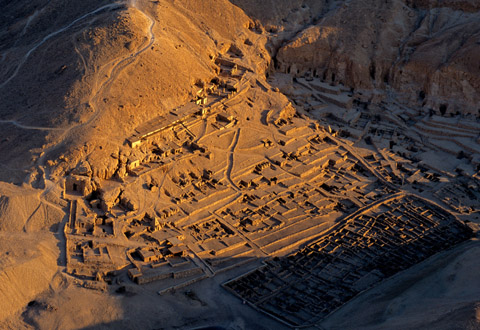Tattooing in Ancient Egypt
In spring 2014, I noticed a well-preserved torso of a mummy with strange markings at the neck. Closer inspection revealed these markings were figural tattoos showing important Egyptian symbols and hieroglyphs: nefer signs meaning good, the Eye of Horus and baboons. Stepping back, I realized this mummy’s tattoos extended along her arms, shoulders and back.
I work as the lead bioarchaeologist for the Institut Français d’Archéologie Orientale’s mission at Deir el Medina. This famous archaeological site housed the families of the workmen who cut and decorated the Valley of the Kings. Deir el Medina was originally excavated in the early to mid-20th century. By the time excavations began, the tombs at Deir el Medina had been pillaged and looted for millennia. The commingled human remains were left in disarray and unstudied for decades. My work aims to reveal what these broken bodies can tell us about life at Deir el Medina. My colleague, Cédric Gobeil, and I undertook a detailed analysis of more than 30 tattoos we could identify on the mummy I studied in 2014.
These tattoos revealed a potentially untold story at Deir el Medina and, more broadly, in New Kingdom Egypt. The placement and symbolism of these tattoos tell us this woman may have served an intimate religious role at Deir el Medina. Several of these tattoos link this woman with the goddess Hathor. For example, dual cows wear Hathor necklaces on their arms. Other tattoos, like a bent-lotus plant, appear as graffiti on the stones of the Ramesside temple to Hathor at Deir el Medina. This hieroglyph served as a link between Hathor and papyrus marshes. Additionally, open lotus blossoms abound on the graffiti of the temple floor and were tattooed on either hip. Though many of her tattoos are still hard to decipher, these show a clear connection to religion and the goddess Hathor.
By tattooing in public regions of the body, the tattoos were intended to permanently mark the woman as associated with religious worship. The Eye of Horus was placed on the throat, the two shoulders and the back; from any angle when one looked at this woman, a pair of divine eyes peered back. These divine eyes were written together with the hieroglyph nefer. This combination forms the phrase “to do good.” This phrase was made even more effective by using a divine eye in place of a normal one. The placement of divine formulas “to do good” on her throat and shoulders may have magically imbued her song, speech and every arm movement with this ability.
The striking findings run counter to some earlier research in Egyptology, which gave little credit to women in religious practice. Women were often treated only as objects of desire or passive participants in a male-dominated religious hierarchy. One reason for this conclusion is that religious roles in ancient Egypt were identified through titles. These titles help determine a person’s religious importance in ancient Egypt, and priestly titles were always seen as the most important. However, priestly titles for women noticeably dropped off over time in Pharaonic Egypt, leading to the virtual disappearance of priestesses of Hathor in the New Kingdom. Some scholars suggest that this decrease in titles means women were less prominent in religion.
Yet, in the case of the Deir el Medina mummy, a tattooed woman clearly had an important connection to religion. While we cannot give her a priestly title, the permanent, public and religious nature of her tattoos indicates that women’s religious roles in ancient Egypt were more complex than titles suggest. With divine eyes placed all over her body, this woman may have even embodied the goddess herself.
Research on tattooing in Egypt is just beginning with new technology, changing perceptions and interpretation of these recent discoveries. Since examining this mummy, I have found others with tattoos at Deir el-Medina. The revelations there and elsewhere show that we are only now discovering tattooing as a significant practice.
Changing perceptions of tattoos has forced researchers to reconsider their meaning and value in past cultures. Louis Keimer, who authored a key text on tattooing in ancient Egypt, wrote that all tattooed women in Egypt were “prostitutes of dubious morality.” Yet in recent decades, the surging popularity of tattoos has shifted perceptions. More articles have been published since 2000 on ancient tattoos than in the entire 20th century. This trend is partially due to new technology, including infrared imaging, that makes research into ancient tattoos a promising new field.
In Egypt, exciting discoveries have revealed tattoos in recent excavations at Hierakonpolis and, in plain sight, in the mummies of the British Museum. My work has helped reveal ancient Egyptian practices of tattooing and break down stereotypes about the meaning and value of tattoos. This once-taboo art may hold a new key to understanding life in ancient Egypt.

